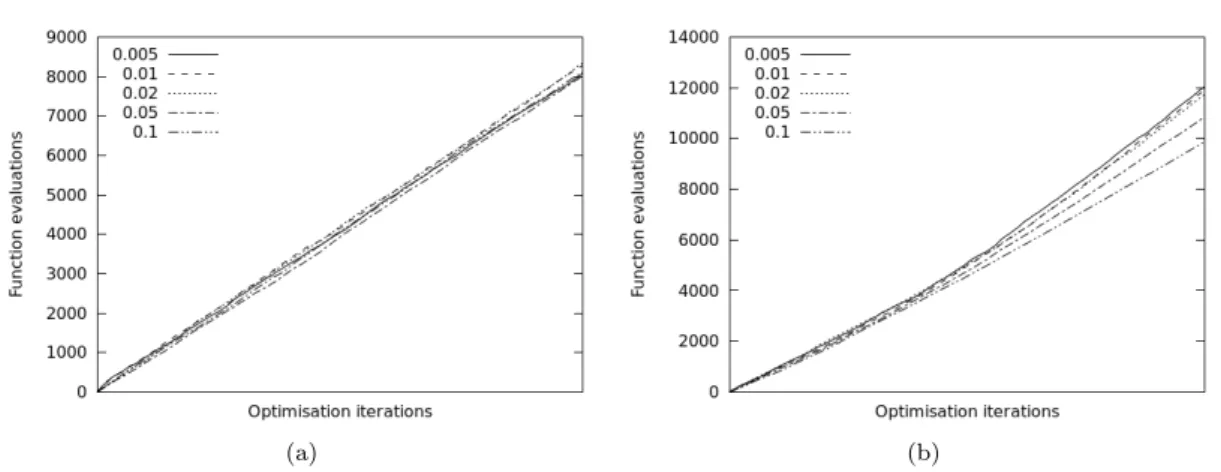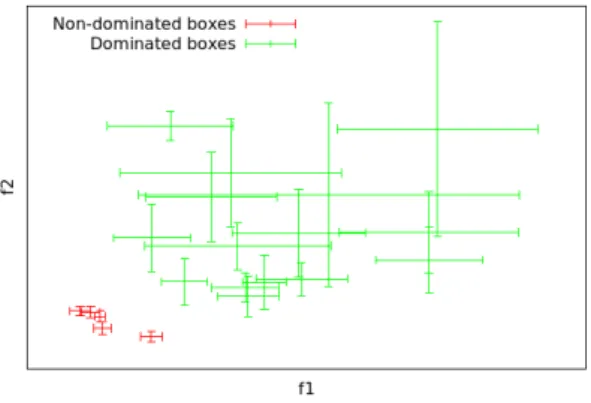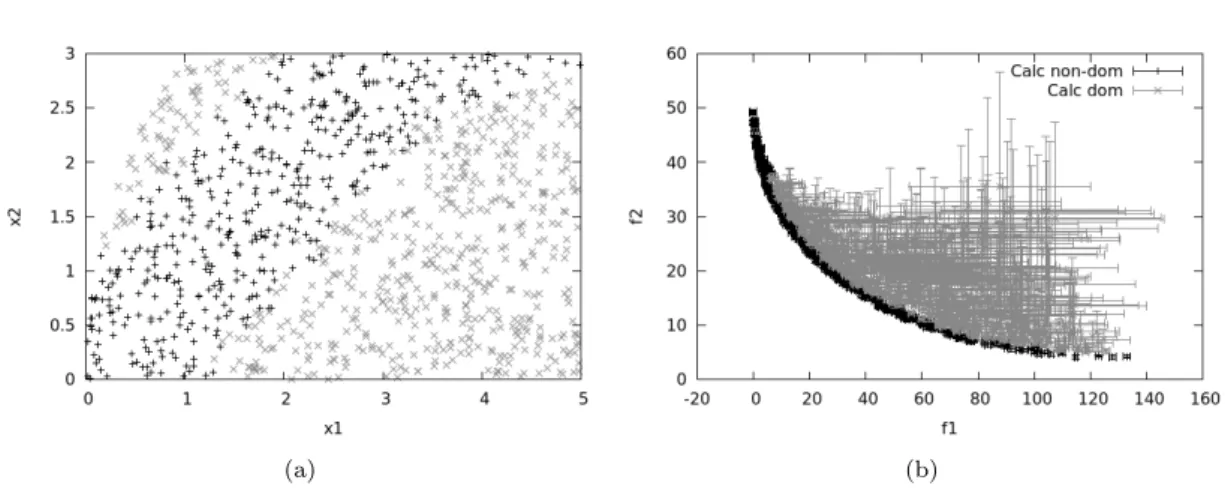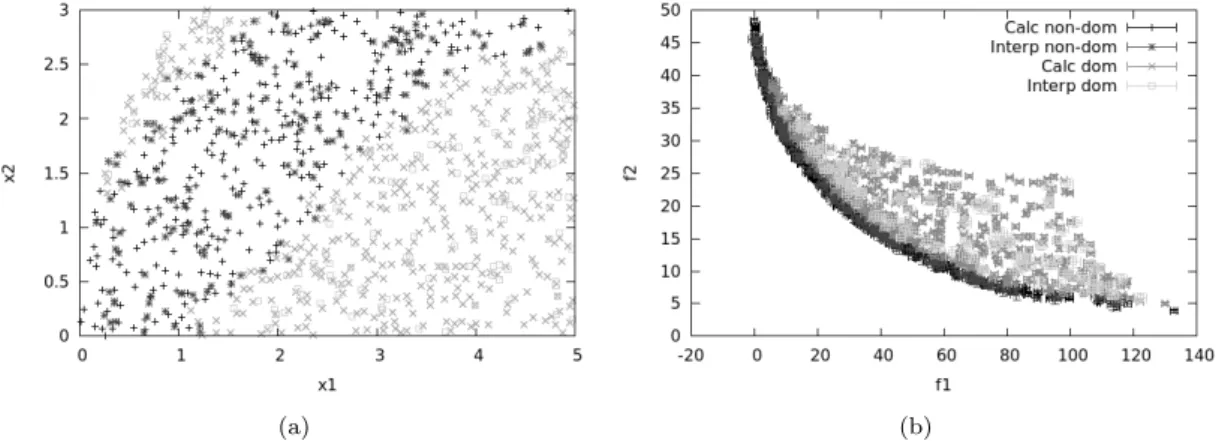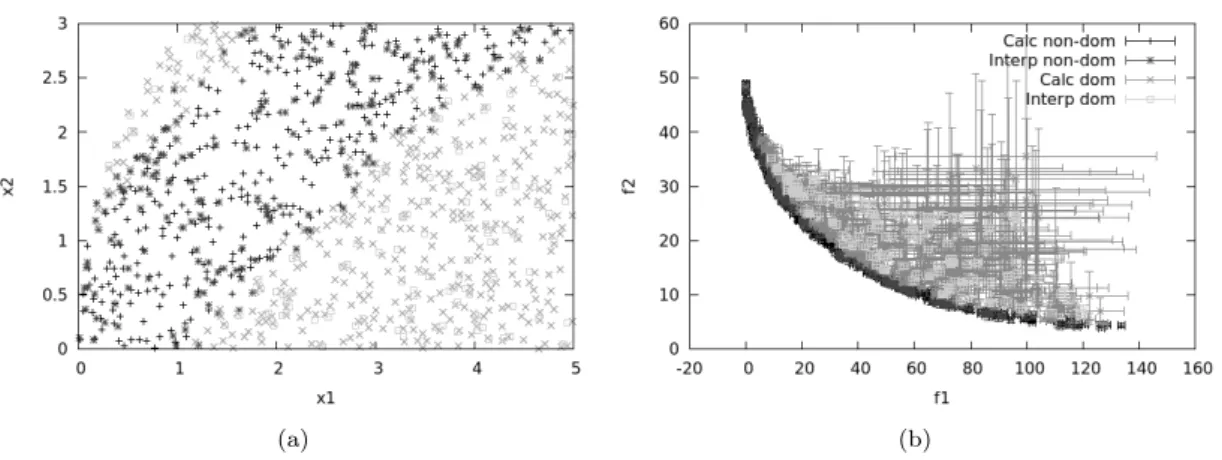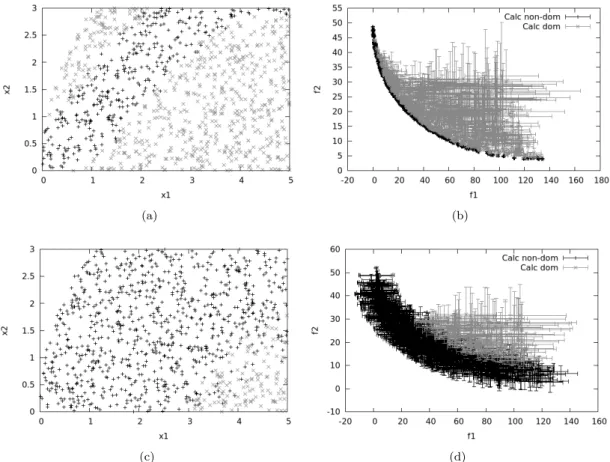This ultimately allows for a further reduction in the cost of calculating the Pareto front by approximating the objective functions at a negligible cost. In many real applications, the evaluation of objective functions can be affected by a source of uncertainty, noise, or error. Such errors can also relate to the variability of the objective values in the context of noisy optimization.
However, in the literature, the main strategy to account for uncertainty on the objective functions is to use probability ranking of the individuals. This approach is then described in Section 2.3, followed by the description of the surrogate-assisting strategy. The objective functions are approximated by a quantity fek, which corresponds to a refinement level of error εk, thus atfek =f−εk.
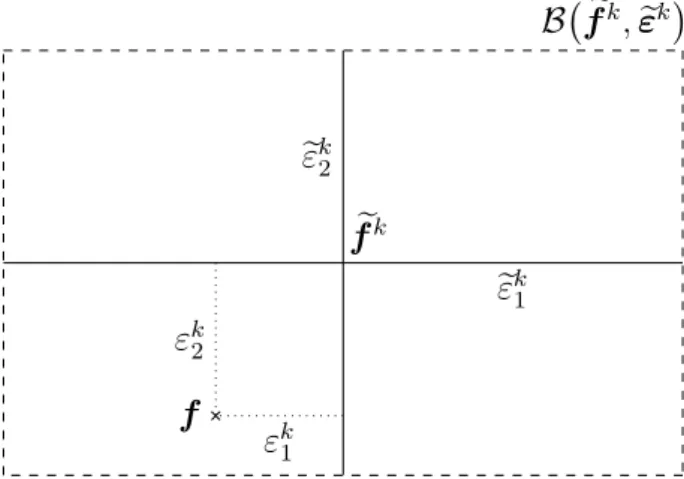
Structure of the framework
If this approximation error is low enough, the predictive value of the surrogate in the new design is returned directly to the optimizer. The selected surrogate model must allow the calculation of an approximation of the error to detect the convergence of the surrogate. Note that no specific fallback method is chosen here, as the SABB framework can be used regardless of the fallback model the user should choose.
Second, the convergence of the method is demonstrated when the surrogate support strategy is used.
Bounding-Box definition and convergence analysis
10, towards the exact Pareto-optimal region when the number N of plans visited and the improvement of the objective functions tend to infinity. As shown below, the assumption that this error is conservative is necessary to demonstrate the convergence of the proposed approach. Let us now define the classical and recursive (developed in [35]) approaches introduced to obtain the refined discrete front approximation.
The difference between these approaches lies in the recursive aspect of the second sequence, which is of great importance. And, as the proof of this theorem shows, any unsatisfied non-dominating condition implies a strict inclusion between two sets of the sequence. More precisely, the goal is to demonstrate the convergence of the continuous Pareto frontPec built on the approximate matefek Xef,k.
A novelty of this work compared to Fusi's Bounding Box approach in [35] is the possibility to impose an accuracy threshold for the convergence of the objective functions. This would imply convergence of the preimage, due to the continuity hypothesis related to Assumption 3. Convergence of tightest boxes is not required here since the concept of boxes is strongly extended to Pareto optima.
One of the main conclusions of [35] was a significant drop in the performance of the Bounding-Box strategy throughout the run, as the designs converge to the Pareto optimum. This observation has been the starting point of the additional feature of the proposed framework, which is presented in the next section.
Surrogate-assisting model
During the last iterations of the optimization, the surrogate model should be heavily used, as it should already be very accurate in the optimal region. From a numerical point of view, due to the noise on the training points xi,fekmin(xi) on which the surrogate model is built, a regression seems to be more appropriate a priori than an interpolation. On the contrary, a genetic algorithm or any classical iterative optimization process would allow refinement of the surrogate model at each generation or iteration of the optimization.
However, it allows a significant decrease of the global computational cost, especially at the end of the execution, when the surrogate is considered to have converged in the optimal area. The other threshold, s2, is compared to the approximation error of the objective functions, which provides the accuracy at which boxes are not further refined. Here, these thresholds are defined as a percentage of the objective function ranges, which are updated throughout the optimization.
It contains all the non-dominated designs and is updated at each refinement of the objective functions. The main steps are the following: i) in the subroutine compareDesignMM, if the error of the surrogate is low enough, the associated objective values are returned. It returns the first approximations of the objective functions, the coupled objective functionsfOBJ, the box size, and the set of non-dominated non-interpolated new designs.
For each new design, the error of the replacement model is compared to the threshold s1. This section is devoted to the application of the framework on several test cases and performance analysis.
Test-case 1: The BNH problem
Note also that the expansionse2 of the conservative error on the interpolated fields is simply taken to be equal to the thresholds2, which means that only the non-dominant interpolated fields are guaranteed to be conservative. In the following, the proposed framework (SABBa) is compared with three different approaches: .. i) the classic approach (marked as Class), i.e. the non-recursive Bounding-Box approach defined in Def. 10, where each field is refined to a threshold of s2; ii) recursive approach, i.e. Fusi's bounding box strategy [35], where only non-dominated fields are refined to a threshold of s2; iii) the classical surrogate-assisted approach (denoted as Class-acc), where the surrogate is built on converged boxes. a) (b). However, in the objective space, a significant part of the fields is not converged to tos2 in the recursive approach, thus reducing the number of function evaluations and the computational cost of the optimization.
In Figures 7 and 8 the effect of the assisting surrogate model is illustrated for the classical approach and the proposed framework respectively. One can note that the non-dominated area and the Pareto front are similar to the fully computed classical approach shown in Figure 5. More precisely, it improves the slope of the cost curve by a ratio that can be interpreted as the average computational cost in the recursive strategy with respect to the full convergence cost.
This is because the surrogate model requires several optimization iterations before reaching a low approximation error. Therefore, the slope of the cost curve during the first iterations is the same as for the unsupported strategies. However, this threshold has a huge impact on the accuracy of the optimal Pareto set in the design space.
Globally, the framework seems effective as a cost reduction strategy, but requires some adjustment of the thresholds. The next test case deals with an optimization problem with a smaller Pareto-optimal area with respect to the entire space of variation.
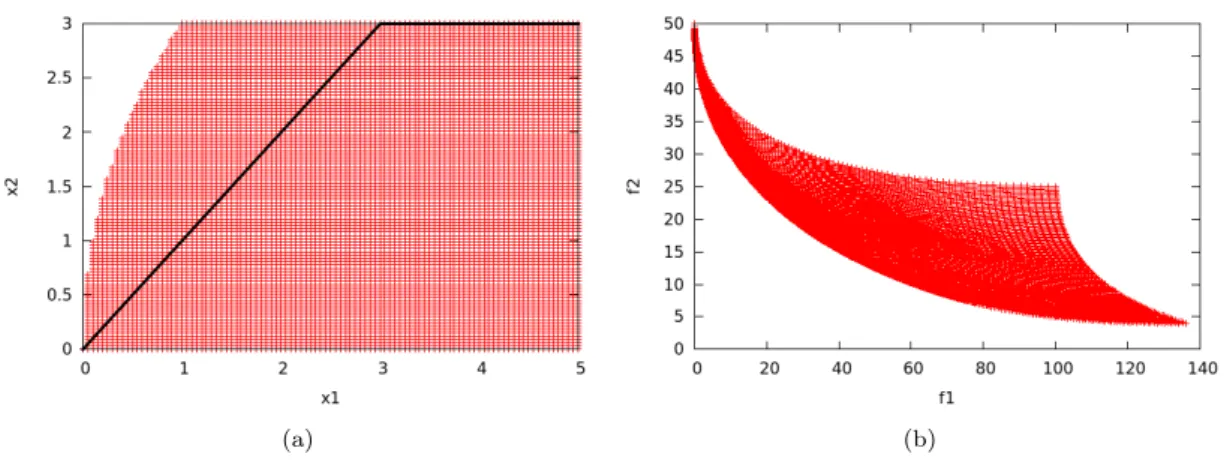
Test-case 2: The Triangle problem
The next test case deals with an optimization problem with a smaller Pareto-optimal area with respect to the entire variation space. Case 2: Classical approach, non-convergent domain for new designs: a) design space, b) objective space. In this case, new designs are randomly chosen in a domain converging towards the optimal region. In practice, with the j optimization iteration, the new designs are chosen as follows, for i i {1,2},. a) (b).
The main effect of the convergence towards the optimal region is a better refinement of the Pareto optima. As concluded in [35], it can be seen that the convergence towards the optimal region induces a diminishing effect of the recursive strategy. This is due to the increasing ratio of non-dominated designs among the convergent search domain.
SABBa relies on the assistant surrogate model to quickly become accurate in the optimal region, which is heavily sampled, ultimately bypassing all feature evaluations in that region. Despite the cost increase of the Fusi strategy alone, SABBa allows fewer evaluations and a much reduced final slope. a) (b). This can also be understood through the impact of afs2 on the cost of both the converging and non-converging optimizations.
15a, the number of non-dominated designs is low enough that the s2 threshold has a negligible impact on the computational cost. On the contrary, the convergence towards the optimal region increases the number of fully converged designs and therefore increases the effect of s2 throughout the iterations, which explains the separation of the curves in Fig.

Test-case 3: The Kursawe problem
This problem is known to have a complex Pareto front with several discontinuities associated with a small area of the design space. The byf image of the entire design space and the associated Pareto front are given in Figs. It can be seen that the front is highly discontinuous and that the range of objective functions should allow a high influence of the recursive strategy through ill-refined dominated boxes.
However, this can be used to obtain a first approximation of the optimal set, as the computational cost here is reduced to 3546 evaluations (gain = 93%). The cost plots given in Figures 20a and 20b show the decreasing impact of the recursive strategy alone and the increasing sensitivity to tos2 throughout the optimization, similar to Figs. It can be seen that due to the small influence of s2 on recursive approaches during the first optimization iterations, the impact of this threshold on the entire SABBa framework is mostly dependent on s1.
Then, a numerical validation was performed to validate the convergence, quantify the computational cost reduction, and express the main behavior of the strategy. Accuracy of the outputs was qualitatively analyzed in relation to the associated cost reduction. Finally, the influence of the user-defined thresholds was investigated, in order to give the keys to tune them efficiently.
Finally, the behavior of the framework when dealing with a large number of parameters has not been addressed here. Note that this problem can be solved by choosing an appropriate surrogate model (ie, automatic goodness-of-fit or an additive kernel for Gaussian processes). Future development will be aimed at applying the proposed framework to an uncertainty-based multi-objective optimization problem in an engineering context and to manage constraint functions.
An adaptive objective function error strategy for uncertainty-based derivative-free optimization.
